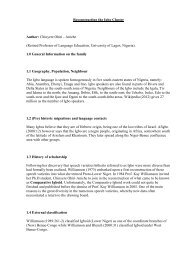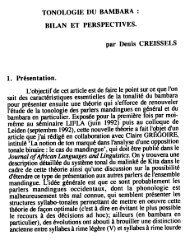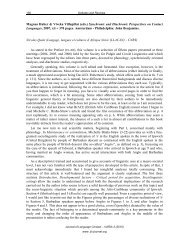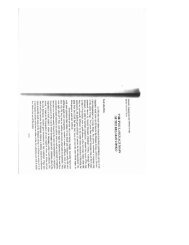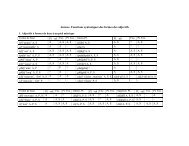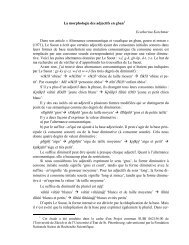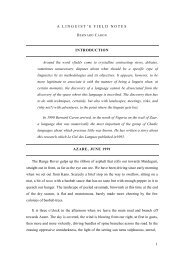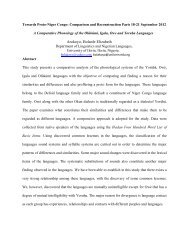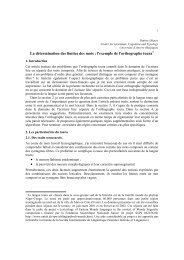Cosper, Ronald. Barawa Lexicon : a wordlist of eight South ... - Llacan
Cosper, Ronald. Barawa Lexicon : a wordlist of eight South ... - Llacan
Cosper, Ronald. Barawa Lexicon : a wordlist of eight South ... - Llacan
You also want an ePaper? Increase the reach of your titles
YUMPU automatically turns print PDFs into web optimized ePapers that Google loves.
<strong>Cosper</strong>, <strong>Ronald</strong>. <strong>Barawa</strong> <strong>Lexicon</strong> : a <strong>wordlist</strong> <strong>of</strong> <strong>eight</strong> <strong>South</strong> Bauchi (West Chadic) languages :<br />
Boghom, Buli, Dott, Geji, Jimi, Polci, Sayanci and Zul, (vol 39). Munich : LINCOM EUROPA, 1999,<br />
158 p. LINCOM Studies in African Linguistics.<br />
The publication <strong>of</strong> new data on little documented Chadic languages is rare enough an event for any<br />
linguist to be enthusiastic when they hear the news. So was I when <strong>Ronald</strong> <strong>Cosper</strong>’s <strong>Barawa</strong> <strong>Lexicon</strong><br />
was announced and published by Lincom Europa. Before this, the main reference on the topic was<br />
(Shimizu, 1978).<br />
Shimizu’s work, written after a survey carried out in 1974 and 1975, comprises <strong>wordlist</strong>s covering 108<br />
items on 32 languages, map, subclassification, cognate percentages, and sound correspondences.<br />
‘<strong>Barawa</strong>’ is a term chosen by Shimizu to name the speakers <strong>of</strong> these 32 languages, which he considers<br />
to be a dialect continuum. He adds that « the use <strong>of</strong> the term ‘<strong>Barawa</strong>’ to denote this group was<br />
confirmed both in the Dass district generally and by the Chief <strong>of</strong> Boot » (op.cit., p. 7). In the various<br />
trips I did to the Dass area, Boot, Sigidi and during my fieldwork in the Sayanci area over the past<br />
decade, the term <strong>Barawa</strong> was accepted by all speakers except those <strong>of</strong> Sigidi and Zaar who don’t know<br />
the word.<br />
<strong>Cosper</strong>’s <strong>Barawa</strong> <strong>Lexicon</strong> covers 915 lexical items for 8 languages : Jimi, Zul, Geji, Polci, Dott,<br />
Sayanci, Buli and Boghom. In the introduction, he gives the chart <strong>of</strong> phonemes for the <strong>eight</strong> languages.<br />
The main interest <strong>of</strong> this work lies then in the increase in the number <strong>of</strong> lexical items documented.<br />
Unfortunately, from what I can judge, the quality <strong>of</strong> the data is far from satisfactory. I will give a few<br />
examples where I will compare <strong>Cosper</strong>’s data with the one I collected on two <strong>of</strong> these languages : Zaar<br />
(<strong>Cosper</strong>’s Sayanci) on which I have been working regularly since 1991, and Zoéi (<strong>Cosper</strong>’s Dott) on<br />
which I did 2 weeks’ fieldwork in 1999.<br />
Zaar<br />
<strong>Cosper</strong> marks two tones for Zaar, although he says « Some <strong>of</strong> these languages, e.g., Sayanci, may in<br />
fact have three phonetic levels <strong>of</strong> tone, but as Schneeberg points out, they are phonologically<br />
analyzable as two-level systems. » Sayanci does have a three-level phonetic tone system. The<br />
phonological two-level system can only be the result <strong>of</strong> a phonological analysis involving a very<br />
elaborate system <strong>of</strong> rules (cf. Schneeberg 74). Failing that, we are left, in the case <strong>of</strong> <strong>Cosper</strong>’s work,<br />
with a two-level phonetic transcription, which in the case <strong>of</strong> Saya, is simply wrong. 1<br />
We will just mention a few cases <strong>of</strong> plain mistakes in marking the tones :<br />
number gloss <strong>Cosper</strong> Own data<br />
2 woman, female gËt gÈt<br />
124 compound dËn dÈn<br />
146 grindstone vúun vuun<br />
148 hut víin vììn<br />
448 war máàndŒ maandŒ<br />
664 fight máàndÉ maandŒ<br />
294 insect zhíßar ???<br />
304 worm zhiߌr ©ìbÈr<br />
Some cases <strong>of</strong> strange translations or notations :<br />
number gloss <strong>Cosper</strong> Own data<br />
5 girl ÑaayŒt (sic !) Ñaa-gÈt<br />
7 daughter nyíi, ÑáagŒt ñíí<br />
688 walk, wander nyalán ÑgeláÑ [ÑgyeláÑ]<br />
453 conversation ÑgáàghŒnlaa ??? 2<br />
508 short afúbm àà fúpm h¢ 3<br />
1 When quoting my own data, I will use a three-level (phonetic) transcription (H= acute ; L = grave ; M =<br />
unmarked ; long vowels will be marked with double letter, each one bearing a tone).<br />
2 I have no translation for the word conversation. Ñgáá‹Ën laa means to rest, lit. to take work (??!!!).
Items 477, 495, 595 and 596 concern the ‘indefinite’ [cf. Hausa wani (sing.) /wasu (pl.)]. As a<br />
determiner, it is postposed to the noun and appears as wón / gón [gwón]. As a pronoun, it has two<br />
forms : gón (sing.) gyaa gón (pl.) resp. [gwón] and [gyaa gwón].<br />
number gloss <strong>Cosper</strong> Own data<br />
477 most gyaagwón ???<br />
495 some (wasu) gyaagwón gyaa gón<br />
595 one (wani) gwán gón<br />
596 some (wasu) gyaagwán gyaa gón<br />
A cursory look at the items concerning demonstratives is sufficient to wonder whether the author has<br />
taken the care <strong>of</strong> reading his manuscript before sending it to the printer. The same translation (gíi) is<br />
given for (601) this and (602) that , which should be resp. gín/giní and gíí, whereas (597) this is given<br />
as gíin and (598) that as gii !<br />
Generally, what strikes the reader when having a cursory look at <strong>Cosper</strong>’s lexicon is the absence <strong>of</strong> a<br />
minimum analysis <strong>of</strong> the data, which leads the author to mistaking syntagms for lexical items, or being<br />
inconsistent in his use <strong>of</strong> verbs or verbal nouns in the translations.<br />
Let’s take the following items :<br />
number gloss <strong>Cosper</strong> Own data<br />
734 fart tuurgunyoghŒn túúr‹Ën ñô‹Ñ 4<br />
748 smell 5 •uughŒnzhóghÑ wúmgËn ©ò‹Ñ 6<br />
75 mouth vii vìì<br />
704 shout dláarvi ›áár‹Ën vìì 7<br />
706 speak wúlvi wúl‹Ën vìì 8<br />
Likewise, (30), saghátkŒn (sa‹átkËn) is the verbal noun <strong>of</strong> sa‹át to be intelligent ; intelligent person<br />
should be mur ‹É sa‹ákËn<br />
The mistakes are too numerous for me to go on listing them. To conclude this passage concerning Zaar,<br />
I will just give the list <strong>of</strong> independant pronouns :<br />
Zo•i<br />
number gloss <strong>Cosper</strong> Own data<br />
608 I myân myááni / myáàn<br />
609 thou kyan kyááni / kyáàn<br />
610 he, she, it yân yááni / yáàn<br />
611 we myâni myààní / myàán<br />
612 you kyáàni kyààní / kyàán<br />
613 they yaashi yààshí<br />
The same problems appear in the work on zo•i. The general impression is that <strong>of</strong> a sloppy work due to<br />
lack <strong>of</strong> analysis.<br />
If one looks at the list <strong>of</strong> verbs given by <strong>Cosper</strong>, it is obvious that some suffixes have not been properly<br />
identified.<br />
3<br />
Lit. : it is not far/long/tall (àà = 3s. Perf.); the negation (h¢) is missing in <strong>Cosper</strong>’s translation. The adjectives<br />
ndóngat or ndúmi are a good translation. So is the verb •at, to be short. The adjective ndúúri is used to<br />
qualify something that has been shortened.<br />
4<br />
Lit : to cook shit ; [ñôghÑ] is in fact /ñôkn/.<br />
5<br />
From the Hausa sansana, one guesses the English verb is supposed to be transitive.<br />
6<br />
Lit : hear/feel a smell. •úghËn is the noun verb <strong>of</strong> the verb •u, to beat. The expression •u zhòghÑ may mean<br />
« to have a strong smell »<br />
7<br />
lit. : cut mouth ; NB : riiÑ = a shout. ÿi‹á (3s. Continuous) riiÑ = he is shouting<br />
8 lit. : say mouth.
The suffix -ti is used in zo•i to form verbal nouns. On the forms given by <strong>Cosper</strong>, the suffix appears<br />
haphazardly :<br />
number gloss <strong>Cosper</strong> Own data 9<br />
715 peep at yéli yeli, yeliti<br />
716 see yeli yeli, yeliti<br />
717 watch yeliti yeli, yeliti<br />
762 blow (<strong>of</strong> wind) bakti fwat; fwatti<br />
763 burn (<strong>of</strong> fire) bak bàk; bàktì<br />
730 desire ndŒkti ndÉkŒ; ndÉkŒti<br />
739 hear, feel wom wóm, womti<br />
Likewise, a -tiya suffix (secondary verbal noun ?) appears in his data, which has not been properly<br />
analysed :<br />
number gloss <strong>Cosper</strong> Own data<br />
675 return doÑtíya dòÑ, dòÑtì<br />
774 break (in pieces) tlaartíya ¨ar, ¨arti<br />
885 be suitable ( ?) taatita, taatiyá taa, taati 10<br />
The perfect/accomplished in zo•i is formed with -ak suffixed to the verb :<br />
number gloss <strong>Cosper</strong> Own data<br />
788 fill zuwak dzù, dzùtì<br />
724 be tired kŒmmak kÉm, kŒmti<br />
691 agree to kappák kap, kapti<br />
As a conclusion, I can only say that this work is seriously questionable, and should never have been<br />
accepted for a publication. It is not a reliable source, and I would not advise anyone to use it for<br />
comparative work.<br />
As matters stand, (Shimizu, 1978) and (Kraft, 1981) remain the only reliable sources.<br />
Bernard CARON<br />
Inalco<br />
UMR 7594<br />
Kraft, Charles H. Chadic Wordlists. Berlin : Dietrich Reimer, 1981. Coll. Marburger Studien zur<br />
Afrika und Asienkunde ; n° 23-25.<br />
Schneeberg, Nan. Sayanci Phonology. Ph.D. : Indiana University. 1974.<br />
Shimizu, Kiyoshi. The <strong>South</strong>ern Bauchi Group <strong>of</strong> Chadic Languages. A survey report. Africana<br />
Marburgensia, 1978, Special Issue 2, p. 50.<br />
9 My own data comes directly from my field notes, and needs to be further analysed, specially concerning tone : I<br />
have heard and marked three tones, which may eventually be reduced to two. For each verb, I give the lexical<br />
form, followed by the verbal noun.<br />
10 For this verb, I have been given the meaning to look like, to resemble.


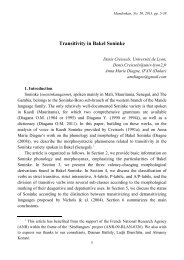
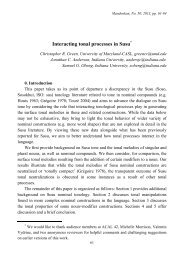
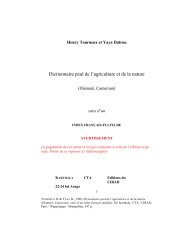
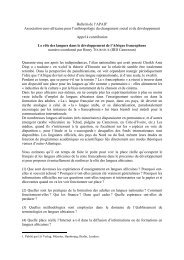
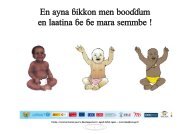
![[halshs-00645129, v1] Depressor consonants in Geji - Llacan - CNRS](https://img.yumpu.com/17832391/1/190x245/halshs-00645129-v1-depressor-consonants-in-geji-llacan-cnrs.jpg?quality=85)
